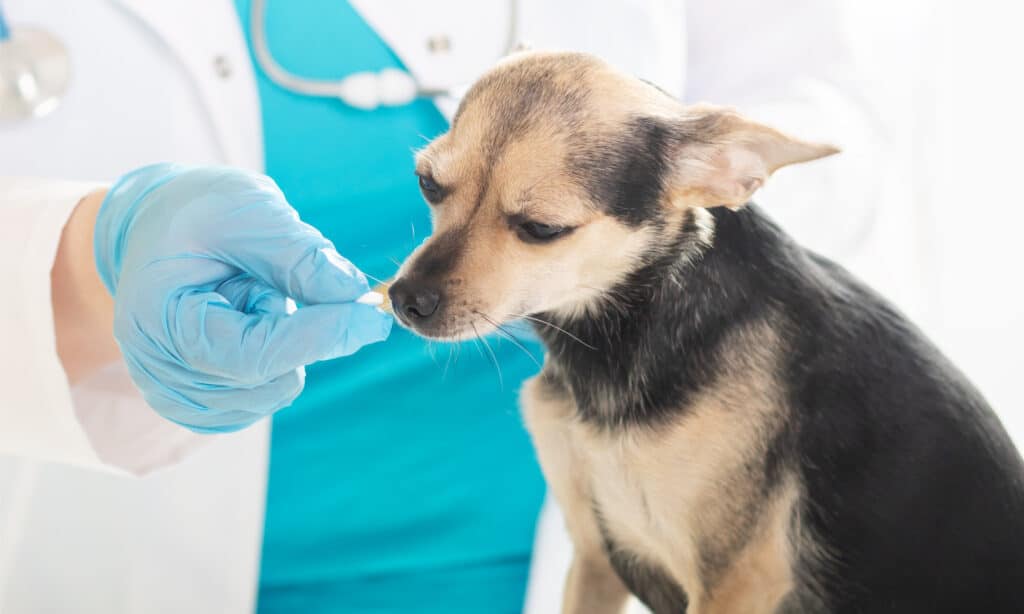As man’s best friend, dogs stick by our side through heartache, loneliness, and depression. And it probably comes as no shock to see your furry companion exhibit human-like emotions and conditions. Like people, dogs can experience stress and anxiety. Maybe they cower at loud noises or shake uncontrollably when traveling in the car. Or perhaps your dog experiences severe separation anxiety. If this sounds familiar, your vet may suggest an antidepressant. Learn about the benefits and side effects of trazodone in dogs, including how long it lasts and how you should use it.
What is Trazodone and How Does it Work?

Trazodone increases mood and lowers anxiety, allowing your nervous pooch to relax and feel calm.
©iStock.com/luchschen
Trazodone is a serotonin reuptake inhibitor antidepressant, which increases serotonin levels in the brain. Serotonin is a chemical messenger that acts as a mood stabilizer. Serotonin levels can affect mood and behavior, and increased levels are responsible for a general feeling of happiness or calmness. Trazodone increases mood and lowers anxiety, allowing your nervous pooch to relax and feel calm. It is available in generic forms or by brand names Oleptro and Desyrel.
Trazodone may be prescribed to dogs who experience:
- Separation anxiety
- Stress
- Anxiety
- Aggression
- Excessive barking
- Compulsive behaviors
Trazodone therapy can help dogs who get nervous leaving the house, those fearful around loud noises, or dogs who feel anxiety during boarding and vet visits. Due to its sedative effect, trazodone is sometimes used with anesthesia during medical procedures. And can be used in conjunction with other medications to treat dogs with aggressive behaviors. A vet may also prescribe trazodone when your dog is recovering from surgery to keep them relaxed and less active.
What are the Benefits of Trazodone?
Trazodone is used to treat several conditions and provides these benefits:
- Reduces stress and anxiety
- Improves behavioral issues, such as aggression, compulsive behavior, and excessive barking
- Lessens separation anxiety
- Decreases fear and anxiety, making car rides, vet trips, and other travels easier
- Increases relaxation during post-op recovery and exams
- Tempers nerves during fireworks and thunderstorms
What are the Side Effects of Trazodone in Dogs?

Trazodone can cause side effects like drowsiness, lethargy, vomiting, and loss of muscle control.
©NayaDadara/Shutterstock.com
Trazodone has many benefits that can greatly increase the quality of life for you and your dog. But like any drug, there are potential side effects you should consider before making a decision. Go over these with your veterinarian and discuss your concerns.
Side effects of trazodone in dogs:
- Drowsiness
- Lethargy
- Dilated pupils
- Colitis
- vomiting/gagging
- Loss of muscle control
- Increased hunger
- Diarrhea
- Hyperactivity
- Priapism (prolonged and painful erections)
- Aggression
- Anxiety
- Heart arrhythmia
- Liver damage in rare cases
There is also a risk of serotonin syndrome when trazodone is combined with other serotonergic drugs. This condition occurs when there is excessive serotonin in the body, which can cause severe symptoms and potentially life-threatening. If your dog is experiencing a fever, increased heart rate, behavior changes, and altered mental state, seek immediate medical attention. You should make your vet aware of all your dog’s medications, including vitamins and supplements, before deciding on a proper course of action.
How Fast Does Trazodone Work and How Long Does it Last?

Dogs who take trazodone regularly to treat generalized anxiety can expect the full benefits within two to four weeks.
©iStock.com/SeventyFour
Trazodone can be prescribed for short-term and long-term conditions. You can expect the drug to take effect quickly, within 30 minutes to an hour, and peaking around three to twelve hours after administering. You can give to your dog with or without food, but it may be more effective and lessen adverse side effects (nausea and vomiting) with a small amount of food. If you do give your dog trazodone with food, it can take longer for the results to “kick in.” Dogs who take trazodone regularly to treat generalized anxiety can expect the full benefits within two to four weeks.
If you are giving your dog this medication for immediate short-term advantages, you can expect the drug to wear off within six to twelve hours. Half of the drug is cleared from the body around three hours after administering the medication.
How Should You Use Trazodone?
Many pet owners may see trazodone as a means to control their dog’s anxiety on an “as-needed” basis. But most veterinarians will prescribe this medication to treat general stress and anxiety in the long term. Your vet may recommend using trazodone combined with other medications to receive the max benefit. You would most likely administer the treatment to your dog on a regular daily basis. Trazodone is typically in pill form, ranging from one to 19 milligrams, depending on your dog’s weight.
Now that you understand how trazodone in dogs works, discuss all of your options with your vet. A licensed professional can help you make an informed decision and administer the correct dosage.
Can You Give A Dog Benadryl for Anxiety?

It’s important to consult with your vet before giving your dog any medication, like Benadryl.
©iStock.com/Yana Tikhonova
While trazodone can be an excellent medication for your dog’s anxiety, you may be wondering if there is an alternative that doesn’t have to be prescribed. Benadryl, if given in a safe amount, can help dogs with anxiety as well as motion sickness, allergies, and vaccine side effects. When determining the dosage, give your dog 0.9-1.8 mg per pound of weight; a typical Benadryl capsule contains 25 mg. It is important to make sure the Benadryl is free of diphenhydramine, which can be harmful for dogs.
*Note: this article does not attempt to give medical or veterinarian advice. Always speak with a licensed professional before starting your dog on medication, mixing medication, etc.
Ready to discover the top 10 cutest dog breeds in the entire world?
How about the fastest dogs, the largest dogs and those that are -- quite frankly -- just the kindest dogs on the planet? Each day, AZ Animals sends out lists just like this to our thousands of email subscribers. And the best part? It's FREE. Join today by entering your email below.
Thank you for reading! Have some feedback for us? Contact the AZ Animals editorial team.








